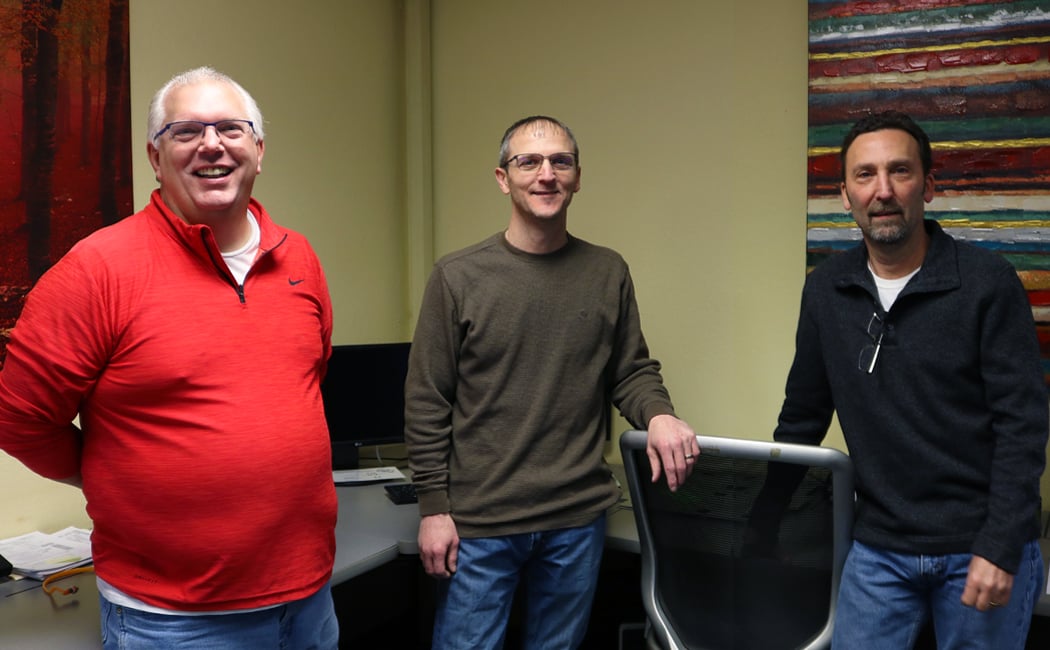The industrial design engineering team at HUI has been with the company for many years now. In fact, the longest-standing team member, Chris Freund, has been engineering with HUI for 29 years. Wayne Schad has been engineering for 13 out of the 25 years he’s worked for the company. Lastly, Scot Hoerth has also been engineering at HUI for 13 years. Over this time they’ve gained a wealth of valuable knowledge and experience with each new industrial design project. That’s why we thought we’d share some of the secrets they’ve learned from 55 combined years of engineering for manufacturing at HUI.
 (Left to Right: Chris Freund, Wayne Schad, Scot Hoerth)
(Left to Right: Chris Freund, Wayne Schad, Scot Hoerth)
20 Secrets about Engineering for Manufacturing
1. Check prints/cad models very closely. Sometimes customer-supplied cad models and prints do not have every change marked or even listed in the revision table, so catching these discrepancies early in our process is key. When designing in-house, be it a multi-component weldment or single part, make sure you know what the design intent is around that specific project.
2. When in doubt, use material thickness and the Air Bending Force Chart to determine the bend radius.
3. Laser cutting long narrow strips can create a camber in the part, you can either add additional tabs along the length of the part to hold it in place or punch the part perimeter complete.
4. With a CO2 laser, our best results come when cutting a hole equal to or greater than the material thickness.
5. Avoid forming offsets (jogs) too close to one another. Create a table with the distance between bends, or some other kind of process to verify your tooling will work. Finding standard tooling to form odd dimensioned offsets can be tricky, so it’s helpful to have someplace to start.
6. Keep your information in one place so it is easy to keep track of. You don’t want the same information in four different spots.
7. Creating consistency with your customer’s information will make your life easier.
8. Auto-generate information when you can. Different engineers may change how they display information based on what they experienced over the year. This results in too many variations on prints. To solve this problem, we use multiple auto fill applications for common scenarios.
9. Always verify your pilot size for any inserted hardware when using someone else’s model or cut file (e.g. Auto-sert, weld nuts, etc.).
10. Be cognizant of tolerance stack ups and required weldment tolerances. Customer prints don’t always take that into account.
11. If the manufacturing shop floor has to weld a large part, pay attention when determining the sequencing. Typically, they should start at the center and work out from there, so they are not starting at one end and working all the tolerances one way.
12. When engineering, try to visualize the whole manufacturing process to make sure that one step doesn’t affect another. You should be confident the part will make it through the entire manufacturing process.
13. Packaging is very important. Customers many times ask for specific packing requirements, so make sure to always factor those requirements into your process.
14. Provide your customers with your company’s capabilities and tooling. This helps them understand and design around this information, if they are able and willing to.
15. Design with repeatability and error proofing in mind. Think about what you can do upfront to alleviate questions you might get on the shop floor. It adds more work upfront, but that is much better than clearing up five different questions from five different operators about the same issue.
16. Question prints right away, if something doesn’t seem right, you should clarify. Never assume, because everything needs to match what the customer is expecting, so you shouldn’t just make changes with the hope to correct the print later. Customers could easily send these parts back because they are not manufactured to the print.
17. It’s critical to work well with the shop floor. You’re not going to get anywhere if you’re butting heads, so do your best to work well with everybody.
18. Listen to suggestions from other people. Sometimes you’re so focused on what you’re doing that you miss the easy solutions.
19. Review the print as if you are seeing it for the first time.
20. Do what you say you are going to do. Engineers lose credibility quickly when changes aren’t happening that they’ve agreed to make.
If you’d like to learn more about HUI’s industrial design engineering team, or if you need help with your own custom industrial project, please contact us today!
To get instant updates anytime we have a new blog post, please click here to subscribe to HUI’s Manufacturing Blog.

 HUI dedicates itself to helping our customers design the solutions they need and launching quality products on time and within budget.
HUI dedicates itself to helping our customers design the solutions they need and launching quality products on time and within budget.